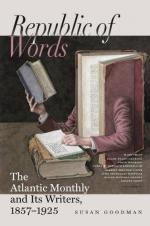—Here the old gentleman took his cane and walked out to cool himself.
FOREIGN.
It is an old remark of Lessing, often repeated, but nevertheless true, that Frenchmen, as a general rule, are sadly deficient in the mental powers suited to objective observation, and therefore eminently disqualified for reliable reports of travels. Among the host of French writing travellers or travelling writers, on whatever foreign countries, there have always been very few who looked at foreign countries, nations, institutions, and achievements, with anything like fairness of judgment and capacity of understanding. For an average Frenchman, Moliere’s renowned juxtaposition of
“Paris, la cour, le monde, l’univers,”
is a gospel down to this day; and no country can so justly complain of being constantly misunderstood and misrepresented by French tourists as ours. The more difficult it is for a Frenchman not to glance through colored spectacles from the Palais Royal at whatever does not belong to “the Great Nation,” the more praise those few of them deserve who give to the world correct and impartial impressions of travel and reliable ethnological works.
Such is the case with two works which we are glad to recommend to our readers. The first is
La Norwege, par LOUIS ENAULT. Paris: Hachette. 1857.
Norway, though a member of the European family, with a population once so influential in the world’s history, is comparatively the least known of all civilized countries to the world at large, and what little we know of it is of a very recent date,—Stephens’s and Leopold von Buch’s works being not much more than a quarter of a century old, while Bayard Taylor’s lively sketches in the “New York Tribune” are almost wet still, and not yet complete. The latter and M. Enault’s book, when compared with each other, leave not the slightest doubt that each observes carefully and conscientiously in his own way, that both possess peculiar gifts for studying and describing correctly what there is worth studying and describing in this terra incognita, and that we can rely on both. Mr. Taylor is more picturesque, lively, fascinating, and drastic; M. Enault more thorough, quiet, and reserved in the expression of his opinions. The parts seem to be interchanged,—the Frenchman exhibiting more of the Anglo-Saxon, the American more of the French genius; but both confirm each other’s statements admirably, and should be read side by side. If our readers wish to make themselves thoroughly acquainted with the workings of the laws and institutions, with the statistical, economical, and geographical facts, the society and manners, the later history and future prospects of Norway, they will find here a work trustworthy in every respect.
Les Anglais et l’Inde, avec Notes, Pieces justificatives et Tableaux statistiques, par E. DE VALBEZEN. Paris. 1857.




